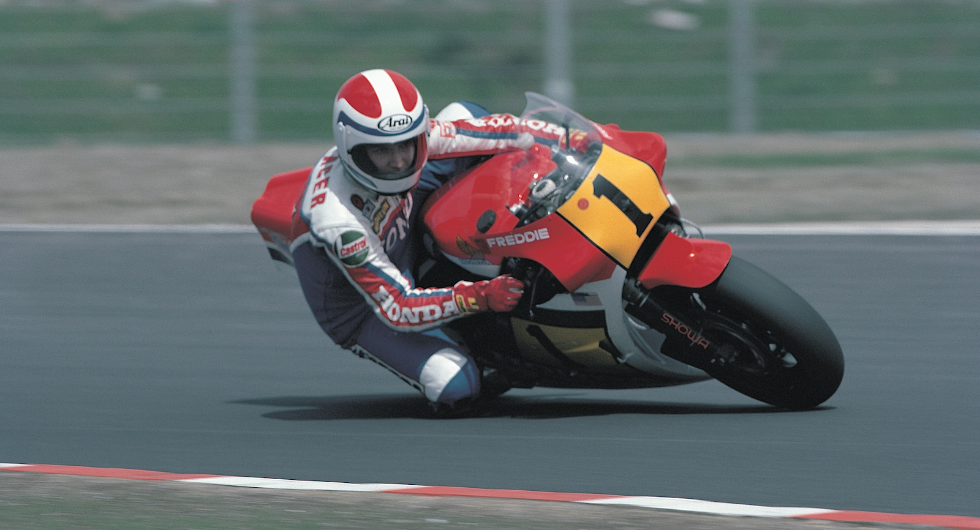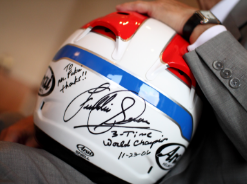Both as an engineer and a leader in the NS500 project
NS500 showed speed but experienced some losses in the first season.
Freddie Spencer ranked 3rd.

At the Belgian GP, the 6th Grand Prix race for the NS500, Spencer was ahead of the pack. He got the long-awaited win with a lead of 3.8 seconds over Barry Sheene on the Yamaha YZR500 in 2nd place. It was too much of a coincidence that the day was the 4th of July, the Independence Day of the United States. (Photo/Shigeo Kibiki)
Honda's works riders who competed in the 1982 World Grand Prix on a brand new NS500, were Marco Lucchinelli, the 500cc world champion of the previous year, Takazumi Katayama who had struggled with the NR500 for the past three seasons, and Freddie Spencer who showed an impressive performance with the NR500 in the previous year.
Spencer, who was widely praised as a genius rider, showed the speed to fight for the top from the opening round, the Argentine GP, but some troubles such as engine seizure often ruined his chances of winning in the first half of the season. In the meantime however, development in Japan brought the NS2A-AL with an all-aluminum frame and it debuted at the sixth round, Dutch TT. At the same time, a swingarm made of carbon fiber (CFRP) was also introduced, making the machine even lighter. At the seventh round, the Belgian GP, innovating a nikasil-plated cylinder enabled the fuel mixture to be reduced from the conventional 25:1 to 30:1. Spencer won his first career victory on the powered-up NS500. It was Honda's first victory since returning to the Grand Prix.
One month later, in the 10th round, the Swedish GP was won by Katayama. At the following event of San Marino GP, Spencer grabbed his second win of the season. In the 1982 Grand Prix series, 12 races were held in the 500cc class, and the NS500s marked 3 wins in their first year. The highest of the championship was Spencer who ranked 3rd, 31 points behind Franco Uncini on the Suzuki RGΓ, who won the championship. The difference between the two was equivalent to the points earned for two victories.
Winning a fierce battle with Yamaha's Kenny Roberts
Spencer becomes the youngest-ever champion

At the 1983 Swedish GP, #3 Spencer and #4 Roberts battled for the win in a stage unmatched by anyone else. Spencer, who won this match, finally became the world champion in the next race, the San Marino GP, the final race of the year. (Photo/Shigeo Kibiki)
In 1983, the NS500 was equipped with a new device called ATAC. This power valve on the exhaust pipe brought a wider power band and increased its fighting potential. In addition to the three riders from the previous year, Honda appointed Ron Haslam to make a four-man works team and let them take part in the World Grand Prix.
Among them, it was Spencer who showed outstanding speed. The 21-year-old American aboard the NS500 won five of the first seven rounds of the 12-round series, ruling the standings as a points leader. However, Yamaha made a counterattack and Kenny Roberts on the YZR500 which had improved in performance, defeated Spencer in three consecutive races, starting with the eighth round, Dutch TT.
The Swedish GP, the 11th round and the penultimate race of the year became a climactic battle, which decided the fate of the 1983 title. Spencer and Roberts entered the race with just two points separating them, and it was a battle that will be remembered for generations to come. It was settled when Spencer took the inside at the right 90-degree corner after the backstretch and pushed Roberts out. Spencer took his sixth win of the season and extended his lead to five points again. At the final round of the season, the San Marino GP, Spencer finished second behind Roberts, who also won his sixth win of the season. The NS500 he rode became the machine that brought Honda its first riders' title in the top category.
The NS500 continued to win even after it finished to be a flagship machine.
Also for the base of the production racer RS500R.

Spencer, who liked the nimble handling of the NS500 often used it in qualifying and final races in the 1984 season after Honda switched to the NSR500 which was equipped with a V-type 4-cylinder engine. At the West German GP in the photo, he won a runaway victory with a gap of nearly 16 seconds over Eddie Lawson, who finished 2nd on the Yamaha YZR500 with a V4 engine. (Photo/Shigeo Kibiki)
In 1984, the year after the NS500 won the premier class of the World Grand Prix, Honda debuted the NSR500 equipped with a V-type 4-cylinder engine, giving this new machine only to Spencer, the reigning world champion. However, due to the adverse effects caused by the unique layout that placed the fuel tank under the engine, and the output characteristics that made it difficult to grasp the traction of the newly developed V4 engine, it was not easy to fully demonstrate the performance.
In the fifth round, the West German GP, the NS had to be prepared and run again. Spencer rode the 3-cylinder machine for the first time in a while, and ran like a fish out of water, giving himself a landslide victory. Also in the ninth round, the Belgian GP, Spencer chose the NS instead of the NSR and won comfortably. At the final round, the San Marino GP, Randy Mamola who was also riding a works spec NS, grabbed the victory, and in the 1985 Dutch TT, Mamola also won with the NS. Even after it was no longer the main force machine, the NS500 continued to demonstrate that it was still competitive in the Grand Prix.
In addition, this V3 engine-equipped machine was also important because it became the base for Honda's first commercially available GP500 road racer. The RS500R released by HRC in January 1983 was a production racer with the same basic engine and chassis design as the works machine; it was endorsed by privateers all over the world who challenged the 500cc class because of the small number of parts and ease of handling 3 cylinders, The RS500R was a product that HRC, shortly after its establishment, showed the significance of its existence. It worked out from the planning stage of the NS500, since a production racer version was also envisioned. The NS500 played a very important role in laying the foundation for Honda and HRC's ongoing road racing activities.

In the first half of the 1980s, even in the top category of the World Grand Prix, about two-thirds of the entrants were privateers. In 1983, HRC launched the RS500R, a production GP500 racer, and it was very well received. The photo shows Jack Middelburg, who rode RS500R in the 1983 season. (Photo/Shigeo Kibiki)





